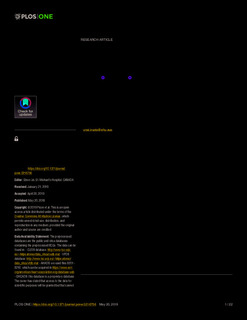| dc.rights.license | Attribution 4.0 International | * |
| dc.contributor.author | Ayala, Unai | |
| dc.contributor.other | Picon, Artzai | |
| dc.contributor.other | Irusta, Unai | |
| dc.contributor.other | Álvarez-Gila, Aitor | |
| dc.contributor.other | Aramendi, Elisabete | |
| dc.contributor.other | Alonso-Atienza, Felipe | |
| dc.contributor.other | Figuera, Carlos | |
| dc.contributor.other | Garrote, Estibaliz | |
| dc.contributor.other | Wik, Lars | |
| dc.contributor.other | Kramer-Johansen, Jo | |
| dc.contributor.other | Eftestøl, Trygve | |
| dc.date.accessioned | 2020-03-26T15:58:15Z | |
| dc.date.available | 2020-03-26T15:58:15Z | |
| dc.date.issued | 2019 | |
| dc.identifier.issn | 1932-6203 | en |
| dc.identifier.other | https://katalogoa.mondragon.edu/janium-bin/janium_login_opac.pl?find&ficha_no=153458 | en |
| dc.identifier.uri | https://hdl.handle.net/20.500.11984/1601 | |
| dc.description.abstract | Early defibrillation by an automated external defibrillator (AED) is key for the survival of out-of-hospital cardiac arrest (OHCA) patients. ECG feature extraction and machine learning have been successfully used to detect ventricular fibrillation (VF) in AED shock decision algorithms. Recently, deep learning architectures based on 1D Convolutional Neural Networks (CNN) have been proposed for this task. This study introduces a deep learning architecture based on 1D-CNN layers and a Long Short-Term Memory (LSTM) network for the detection of VF. Two datasets were used, one from public repositories of Holter recordings captured at the onset of the arrhythmia, and a second from OHCA patients obtained minutes after the onset of the arrest. Data was partitioned patient-wise into training (80%) to design the classifiers, and test (20%) to report the results. The proposed architecture was compared to 1D-CNN only deep learners, and to a classical approach based on VF-detection features and a support vector machine (SVM) classifier. The algorithms were evaluated in terms of balanced accuracy (BAC), the unweighted mean of the sensitivity (Se) and specificity (Sp). The BAC, Se, and Sp of the architecture for 4-s ECG segments was 99.3%, 99.7%, and 98.9% for the public data, and 98.0%, 99.2%, and 96.7% for OHCA data. The proposed architecture outperformed all other classifiers by at least 0.3-points in BAC in the public data, and by 2.2-points in the OHCA data. The architecture met the 95% Sp and 90% Se requirements of the American Heart Association in both datasets for segment lengths as short as 3-s. This is, to the best of our knowledge, the most accurate VF detection algorithm to date, especially on OHCA data, and it would enable an accurate shock no shock diagnosis in a very short time. | en |
| dc.language.iso | eng | en |
| dc.rights | © 2019 Picon et al. | en |
| dc.rights.uri | http://creativecommons.org/licenses/by/4.0/ | * |
| dc.title | Mixed convolutional and long short-term memory network for the detection of lethal ventricular arrhythmia | en |
| dcterms.accessRights | http://purl.org/coar/access_right/c_abf2 | en |
| dcterms.source | PLoS ONE | en |
| local.contributor.group | Teoría de la señal y comunicaciones | es |
| local.description.peerreviewed | true | en |
| local.identifier.doi | https://doi.org/10.1371/journal.pone.0216756 | en |
| local.rights.publicationfee | APC | |
| local.rights.publicationfeeamount | 1695 USD | |
| local.contributor.otherinstitution | https://ror.org/02fv8hj62 | es |
| local.contributor.otherinstitution | Euskal Herriko Unibertsitatea (EHU | es |
| local.contributor.otherinstitution | https://ror.org/01v5cv687 | es |
| local.contributor.otherinstitution | https://ror.org/0537dnd74 | es |
| local.contributor.otherinstitution | https://ror.org/02qte9q33 | es |
| local.contributor.otherinstitution | https://ror.org/01xtthb56 | es |
| local.source.details | Vol. 14. Nº 5. May, 2019 | eu_ES |
| oaire.format.mimetype | application/pdf | |
| oaire.file | $DSPACE\assetstore | |
| oaire.resourceType | http://purl.org/coar/resource_type/c_6501 | en |
| oaire.version | http://purl.org/coar/version/c_970fb48d4fbd8a85 | en |








